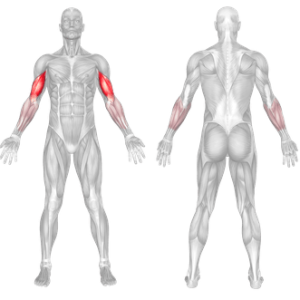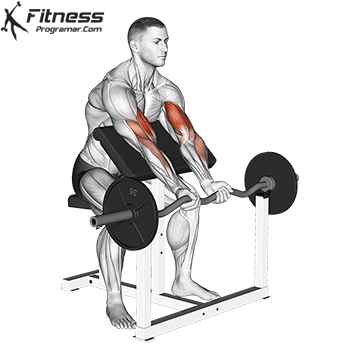EZ Bar Preacher Curl
The EZ Bar preacher curl, a variation of the preacher curl performed with a straight barbell, is an effective isolation exercise primarily targeting the biceps and forearms.
Performing the preacher curl involves using a specialized bench, known as the preacher curl bench, and a curl bar with an underhand grip. This grip positions the wrists and elbows in a way that maximizes bicep engagement, facilitating optimal muscle activation throughout the movement.
The EZ-bar allows for a more comfortable grip, reducing the strain on the wrists and elbows. The preacher bench helps isolate the biceps by keeping the upper arms stationary and eliminating any swinging or cheating that can occur during regular bicep curls.
How To do:
Here are the steps to perform the EZ-Bar Preacher Curl:
- Adjust the preacher bench: Adjust the height of the preacher bench so that the upper arms rest comfortably on the angled pad. Ensure that your chest is in contact with the pad.
- Select the appropriate weight: Select a suitable weight on the EZ-bar that challenges your biceps but allows you to maintain proper form.
- Grasp the EZ-bar: Grasp the EZ-bar with an underhand grip (palms facing up) with your hands slightly closer than shoulder-width apart.
- Position your arms: Position your arms on the angled pad, with your upper arms perpendicular to the ground and your elbows slightly flexed.
- Curl the bar: Keeping your upper arms stationary, exhale and curl the bar towards your chest, focusing on contracting your biceps. Hold the peak contraction for a second.
- Lower the bar: Inhale and slowly lower the bar back to the starting position, maintaining control and tension on your biceps.
Maintain proper form and control throughout the entire movement, focusing on the contraction of your biceps.
Tips:
Maintaining a full range of motion is crucial for reaping the full benefits of the preacher curl. By lowering the weight all the way down and fully extending the arms, you stretch the biceps, enhancing muscle activation and promoting balanced development.
EZ-Bar Preacher Curl Benefits
Size and strength increase:
The EZ-Bar Preacher Curl primarily targets the brachialis and biceps muscles by contracting them against resistance. The brachialis muscle is located on the front of the upper arm, underneath the biceps. When you curl the barbell towards your chest, the biceps contract concentrically, shortening the muscle fibers and generating force. This results in increased activation and development of the brachialis muscle, leading to more overall arm size and strength.
Mechanical Advantage:
The EZ-bar provides a mechanical advantage for the biceps by allowing for a comfortable grip and reducing the strain on the wrists and elbows. This enables you to lift heavier weights and perform more reps, which leads to greater muscle growth.
Isolation of the Biceps:
The preacher bench used in EZ-Bar Preacher Curls isolates the biceps by keeping the upper arms stationary and eliminating any momentum or swinging. This ensures that the biceps are the only muscles responsible for lifting the weight, leading to more targeted muscle activation and growth.
Variation in Training:
The preacher curl emphasizes the use of free weights, which offer several advantages over machines. Free weights promote a more natural movement pattern, engage stabilizing muscles for enhanced balance and coordination, and allow for greater customization of resistance levels to suit individual strength levels.
Overall, the EZ-Bar Preacher Curl is a highly effective exercise for building bigger and stronger biceps. By targeting the biceps muscles with resistance, providing mechanical advantage, isolating the biceps, increasing time under tension, and providing variation in training, this exercise can help you achieve your muscle-building goals.
EZ Bar Preacher Curl – Muscles Worked


